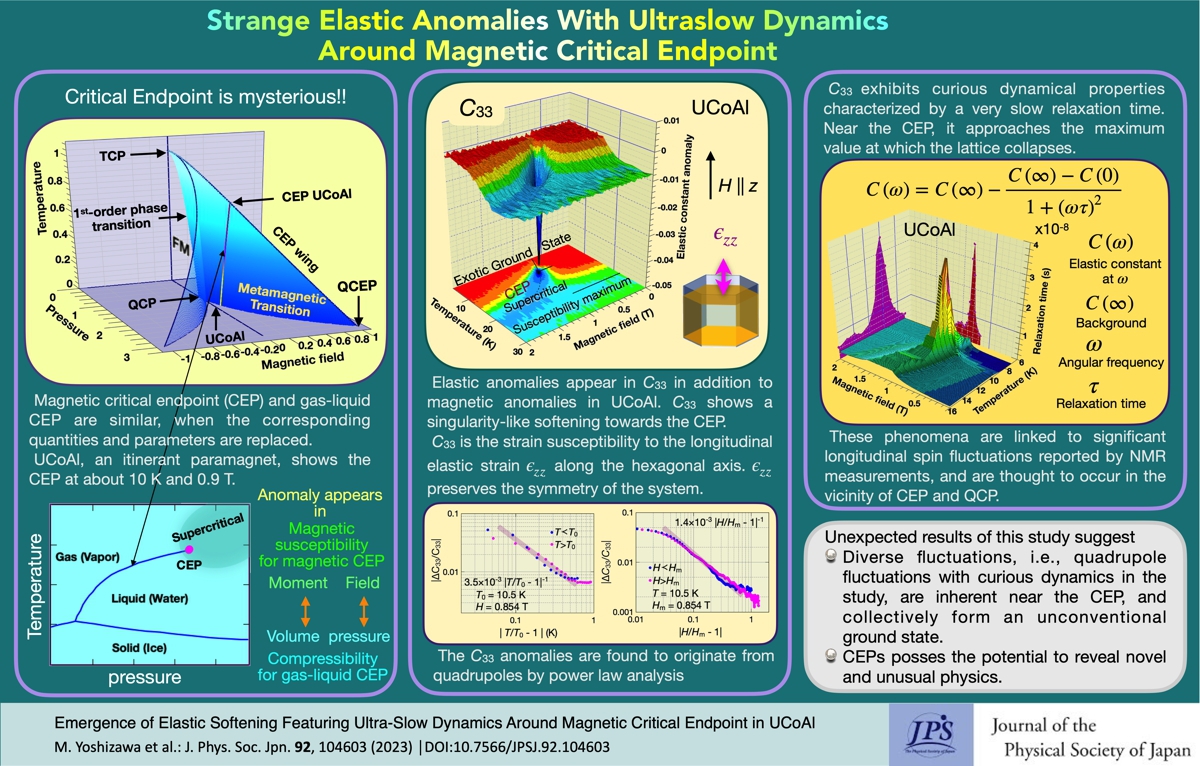Strange Elastic Anomalies with Ultraslow Dynamics around Magnetic Critical Endpoint
© The Physical Society of Japan
This article is on
Emergence of Elastic Softening Featuring Ultra-Slow Dynamics Around Magnetic Critical Endpoint in UCoAl
J. Phys. Soc. Jpn. 92, 104603 (2023).
Near the magnetic critical endpoint of UCoAl, peculiar elastic anomalies exhibiting exotic ultraslow dynamics arising from electric quadrupoles are indicated. Combining this with diverse fluctuations, intriguing phenomena and exotic ground states are expected.

Since the mathematical description of boundary-separating gas and liquid states by van der Waals, the critical endpoint (CEP) has garnered the attention of many researchers because of its intriguing nature. At high temperatures and pressures, water achieves a CEP, in which the gas and liquid phases coexist harmoniously. An anomaly in the compressibility emerges in the water CEP. In magnetic materials, CEP appears as a function of temperature and the magnetic field. The magnetic susceptibility shows an anomaly in the magnetic CEP. Gas-liquid and magnetic CEPs are assumed to be similar. Nevertheless, the presence of non-magnetic fluctuations is unanticipated in magnetic CEPs.
UCoAl, which is an itinerant paramagnet, is located near both the tri-critical point and the quantum critical point (QCP). At ambient pressure, a CEP was observed at approximately 10 K and 0.9 T. In this study, ultrasonic sound velocities ranging from 12 to 106 MHz were measured, and the elastic constant C33, which represents the strain susceptibility for elastic strain (displacement along the hexagonal axis), was obtained. We observed a singularity-like elastic softening toward the CEP and discovered that this anomaly cannot be attributed to magnetostrictive coupling. Power law analyses indicate that it originates from electric quadrupoles.
Furthermore, C33 exhibited a fascinating ultrasonic dispersion effect, in which the elastic anomaly diminished as the frequency increased. The recorded relaxation time of 3.5 × 10-8 s at the CEP is the lowest value reported thus far for solids. This value approached the maximum value, at which the crystal collapsed, thus indicating significant structural fluctuations.
Based on NMR studies, UCoAl exhibits pronounced longitudinal spin fluctuations related to the C33 anomaly. The crystal symmetry of UCoAl remains unchanged at CEPs, and maintains the symmetry of the crystal. Fluctuations in the magnetic and structural properties that retain symmetry coevolve toward the CEP. The unconventional slow dynamics indicate the existence of an exotic ground state in this system, which is believed to emerge near the CEP in distinct and extreme environments.
Recently, peculiar superconducting and quadrupolar states were observed in URhGe, UTe2, and URhSn. The distinct features of UCoAl near the CEP are speculated to be associated with the enigmatic properties of these compounds.
CEPs contribute to various fields ranging from industrial processes to particle physics. Despite extensive research, the nature of CEPs remains unclear. CEPs can potentially reveal novel and unusual physics, thus presenting an interesting avenue for investigating undisclosed facets of matter.
Written by M. Yoshizawa on behalf of all the authors.
Emergence of Elastic Softening Featuring Ultra-Slow Dynamics Around Magnetic Critical Endpoint in UCoAl
J. Phys. Soc. Jpn. 92, 104603 (2023).
Share this topic
Fields
Related Articles
-
Antiferromagnetism Induces Dissipationless Transverse Conductivity
Electronic transport in condensed matter
Magnetic properties in condensed matter
Electronic structure and electrical properties of surfaces and nanostructures
2024-7-24
An investigation using high-quality NbMnP crystals demonstrates that the anomalous Hall conductivity arising from antiferromagnetism is dissipationless, as expected from the intrinsic mechanism.
-
Structural Rotation and Falsely Chiral Antiferromagnetism: A New Combination Generating Ferrotoroidic State
Magnetic properties in condensed matter
Dielectric, optical, and other properties in condensed matter
2024-7-4
The ferrotoroidic state, an exotic state of matter with broken space inversion and time-reversal symmetries, was achieved by combining structural rotation and falsely chiral antiferromagnetism in PbMn2Ni6Te3O18.
-
Understanding Electronic Ordering and Cross Correlations with Multipole Representation
Magnetic properties in condensed matter
2024-6-12
This study reviews the recent advancements in research of multipole representations for understanding electronic orderings and cross-correlations in materials and presents future research directions.
-
Evaluation of the Exchange Stiffness Constants of Itinerant Magnets from the First-Principles Calculations
Electron states in condensed matter
Structure and mechanical and thermal properties in condensed matter
2024-6-5
Using first-principles calculations, we evaluated the exchange stiffness constants of ferromagnetic metals at finite temperatures. The constants can be used as parameters in the Landau–Lifshitz–Gilbert equation.
-
Microscopic Exploration of Electronic States in Nickelate Superconductors
Magnetic properties in condensed matter
Superconductivity
2024-5-31
The multilayered nickelates, La3Ni2O7 and La4Ni3O10 , were investigated using nuclear magnetic resonance (NMR) at ambient pressure. Metallic electronic states under the density wave order were observed microscopically for both compounds.
